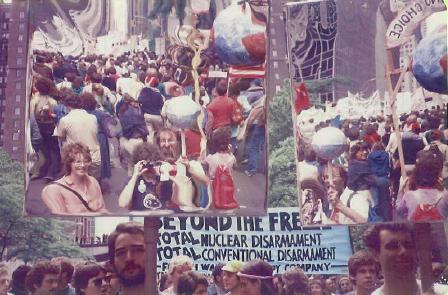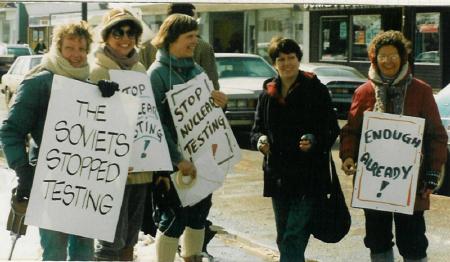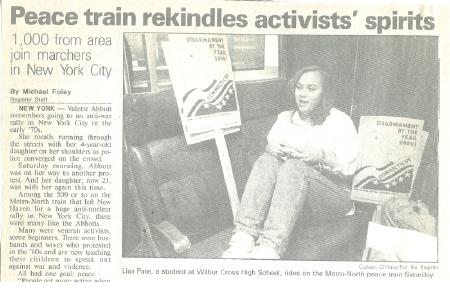Stories
Psychology for Revolutionaries
Psychology for Peace Activists
Why there are so few women warriors
The Seville Statement on Violence
A theory of mental illness
* * *
During the Cold War from the 1970's until the 1990's, more often than anyone knows, the world came close to the total destruction of a nuclear war. One such story is on CPNN, called "The Colonel Who Saved the Earth." In the face of this danger, like others, I could not sit still. I worked on American-Soviet Friendship and the Peoples Appeal for Peace., which probably helped us avert a nuclear war.
The largest movement of this period, as I have documented in the American Peace Movements was the Nuclear Freeze Movement. And the largest rally took place on June 12, 1982, to mark the First United Nations Special Session on Disarmament, which was not long after our return (Lindsay and me) from my trip to Soviet Georgia in the fall of 1981. June 12 was a beautiful sunny day and everyone came to march with their creative costumes and banners and placards. See one of our photos below. Aerial photos were published in major newspapers the next day, by which one could estimate that there were indeed one million people on Sheep's meadow in Central Park!

A photo taken into a reflecting mirror near Grand Central on the great peace march of one million people in 1982. Lindsay is taking the photo and I am next to her. Click on photo to enlarge.
Lindsay worked in the Branford chapter of the Nuclear Freeze during the 80's, and while I tried to work at a statewide level, it was difficult because there was a great deal of anti-communism among the leaders and I was working with the Connecticut Association for American-Soviet Friendship.

A Nuclear Freeze vigil in Branford - Lindsay is at the right. Click on photo to enlarge.
When the movement for a Nuclear Freeze decided to merge their offices and chapters in 1986 with SANE, the committee for a Sane Nuclear Policy, the merger committee chose two essays for the merger booklet, an excellent piece on racism by Jack O'Dell and an essay by me based on The American Peace Movements, warning against anti-communism and taking account of the important role of the Left and the working class.
This provoked contraversy, in particular a long letter of criticism from Homer Jack, a Unitarian minister from Chicago who had long been recognized as a pacifist leader. He wrote on November 5, 1986:
Whoever commissioned your piece in the Handbook certainly did not have the best interests of the Freeze and SANE at heart. That is evident by the approach of your pamphlet. Your history repels the middle - just the people we need to make any difference. I think the U.S. peace effort could gain by input from genuine marxist scholars, including historians, but not the half-baked "history" you are writing.
I replied that "my reading of the history of the mass peace movements of American history [shows] that these movements become politically powerful only when the US working class was engaged. This does not imply that we should adopt a strategy of repelling the middle class, but rather a strategy of expanding the peace coalition."
In December of 1986, I again braved the anti-communism of many participants in SANE/Freeze to get their endorsement of the Peoples Peace Appeal, although as I describe in that section, it was probably a tactical error on my part that led to its failure.
Although Lindsay and I went on many marches and demonstrations during the 1980's, it wasn't until 1988 that I became a major organizer for one of them; the peace demonstration to mark the United Nations Third Special Session for Disarmament. Working again with Tom Holahan, with whom I had worked on the Peoples Peace Appeal and the New Haven Peace Commission, and a young man named Mike Morand whom we hired for the occasion, we brought almost a thousand marchers, mostly teenagers, to the UN and back on June 11, 1988.
I recall vividly the day that I went to the ticket window at the New Haven railroad station and said "I want to hire a train for June 11." "Do you mean a ticket?", the cashier asked. "No, I mean an entire train," I said. Not only did we engage hundreds of teenagers, but they all paid for their own trips on the train to New York and back. And none of them got lost, which was of special importance because I was responsible to their parents!
It turned out to be the largest peace march in the US since that of June 12, 1982.
We prepared and distributed to all of the New Haven participants as they returned on the train a thick book with flyers from all the sponsoring organizations, in the hopes that they would get involve. These included the New Haven Free South Africa Coalition, the Third Congressional District SANE/Nuclear Freeze Campaign, the New Haven Green Party, Physicians for Social Responsibility, the Greater New Haven Peace Council, the Coalition against Radioacive Radio, the Peoples Daily World, the El Salvador Sister City Project, the Cheshire Alliance for Peace, the Save Our Neighborhoods campaign to elect Pamela Saffer as State Representative, the Unitarian Society, the New Haven Peace Center, Promoting Enduring Peace, the Women's International League for Peace and Freedom, Connecticut Labor for Peace and the Connecticut Association for American-Soviet Friendship. Many of these were organizations with which I worked, and I was the main organizer of the last two.
A year later in 1989, Basing our organizing in the New Haven chapter of the Freeze, and the New Haven City Peace Commission, a group of us (again including myself and Tom Holahan), placed a question on the ballot for the city elections in November. The referendum stated, "More federal tax dollars should be given to New Haven and other cities for [a long list of social services]. This should be done by cutting the military budget. The government should guarantee conversion from military to civilian production without loss of jobs or income." We did an excellent campaign throughout the community, similar to what Tom Holahan and I had done previously in New Haven for the Peoples Peace Appeal, and we distributed a beautiful brochure with quotes from community leaders. As a result we got an 83% vote for this proposition.
 |
Stages
1986-1992
Fall of Soviet Empire
1992-1997
UNESCO Culture of Peace Programme
